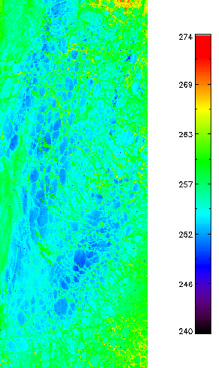NASA Ice Surface Temperature Products
Product User Guide
PI - Mark Tschudi (Univ of Colorado)
Product ATBD
Co-Is: Dorothy HALL (University of Maryland), George Riggs (SSAI GSFC)
Ice Surface Temperature

VNP30.A2014255.2110, 2110 UTC, 12 Sep
2014. IST map during fall freeze-up in the
Beaufort Sea.
The NASA VIIRS Ice Surface Temperature (IST) product provides surface temperatures retrieved at VIIRS moderate resolution for Arctic and Antarctic Sea Ice, for both day and night.
The NASA VIIRS IST algorithm uses a split window approach, which is similar to the MODIS IST algorithm, originally developed by Key and Haefliger [1992]:
IST = a + b(M15) + c(M15 - M16) + d[(M15 - M16)×(sec(θ)-1)]
where a, b, c and d are calibration coefficients, defined for temperature ranges where M15 < 240K, 240K < M15 < 260K, and M15 > 260K. The M15 and M16 temperatures are VIIRS top-of-atmosphere medium-resolution brightness temperatures, centered at 10.7µm and 12.0µm, respectively, and θ is the satellite zenith angle.
This approach provides for MODIS continuity. The different coefficients for the three temperature ranges account for differences in water vapor and provides greater ability to fine-tune the algorithm
The products are provided in NETCDF format. Currently, this collection is available from January 19, 2012 and forward. Products from the VIIRS sensor aboard JPSS-1 (J1) will be also be available starting in mid-2023.
Product Details and Links to NSIDC DAAC
| Product Name | SNPP | JPSS-1 |
|---|---|---|
| Ice Surface Temperature 6-Min L2 Swath 750m | VNP30 | VJ130 |
| Ice Surface Temperature Daily L3 Global 1km EASE-Grid Day | VNP30P1D | VJ130P1D |
| Ice Surface Temperature Daily L3 Global 1km EASE-Grid Night | VNP30P1N | VJ130P1N |


